XFX’s Radeon HD 7970 Black Edition Double Dissipation: The First Semi-Custom 7970
by Ryan Smith on January 9, 2012 6:00 AM ESTOverclocking
Though XFX does not provide any overclocking tools for the BEDD, the card itself is advertised as an overclocking card to an extent. The use of the AMD PCB and a similarly high performing cooler means that overclocking results shouldn’t be much better or much worse than reference cards, but given how much potential we’re seeing out of the 7970 this is not a bad thing.
Even with XFX’s factory overclock the BEDD features the same 1125MHz overdrive limit as all current 7970 cards, so you have 125MHz (~11%) to play with within Overdrive. Based on our experience this is right at the edge of what’s this card is capable of – after pushing the card to 1150MHz through MSI’s Afterburner software we found that our sample peaked at 1125MHz anyhow, as anything beyond that impacted stability and caused artifacts. Meanwhile we were able to push our memory to 6.3GHz, as beyond that point performance plateaued as the need for error correction nullified our gains.
Our final clocks were 1125MHz core and 6.3GHz memory, representing a 21% core and 14% memory overclock over the reference 7970, or an 11% core and 11% memory overclock over XFX’s factory overclock. As the BEDD uses an AMD PCB it should be possible to use compatible voltage tweaking software to push it further, but for the time being we’re limiting ourselves to what the 7970 can do on stock voltage as the AMD PCB isn’t particularly overbuilt for overvolting. On that note we did increase our PowerTune limit to +20% (300W) in order to ensure PowerTune didn’t throttle our overclocked BEDD, though there appears to be headroom to spare in at least some of our games.
| Radeon HD 7970 Overclocking | |||||
| Radeon HD 7970 Stock | XFX Radeon HD 7970 BEDD | XFX Radeon HD 7970 BEDD Overclock | |||
| Core Clock | 925MHz | 1000MHz | 1125MHz | ||
| Memory Clock | 1.375GHz (5.5GHz effective) GDDR5 | 1.425GHz (5.7GHz effective) GDDR5 | 1.575GHz (6.3GHz effective) GDDR5 | ||
| Voltage | 1.17v | 1.17v | 1.17v | ||
| PowerTune | 250W | 250W | 300W | ||
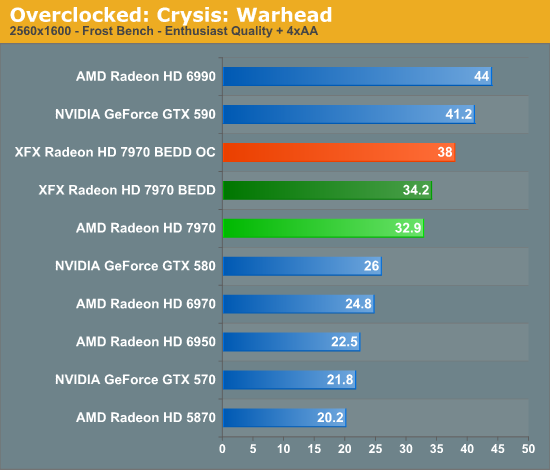


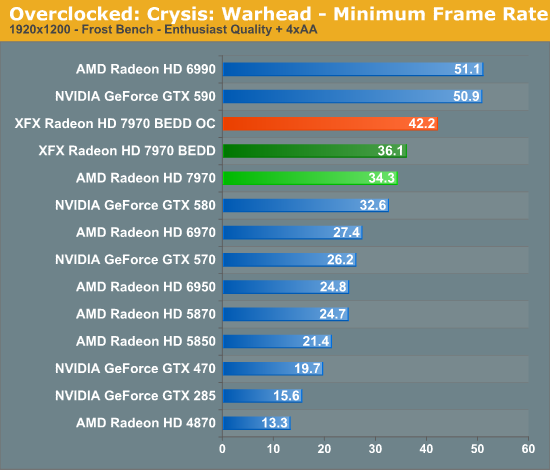
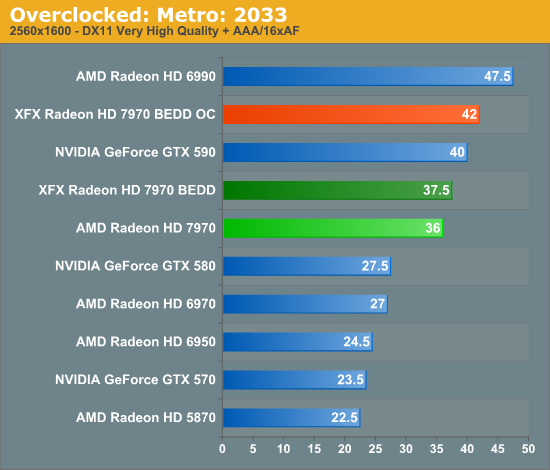

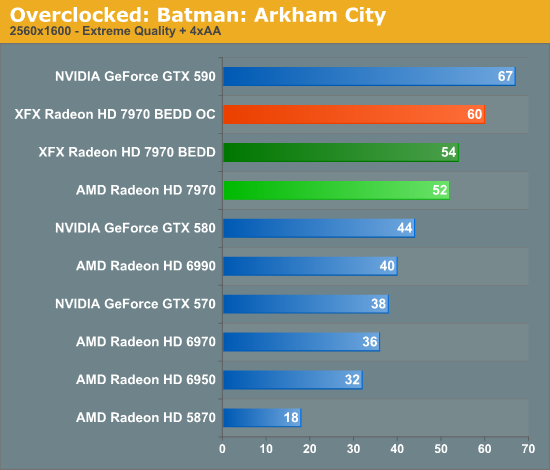
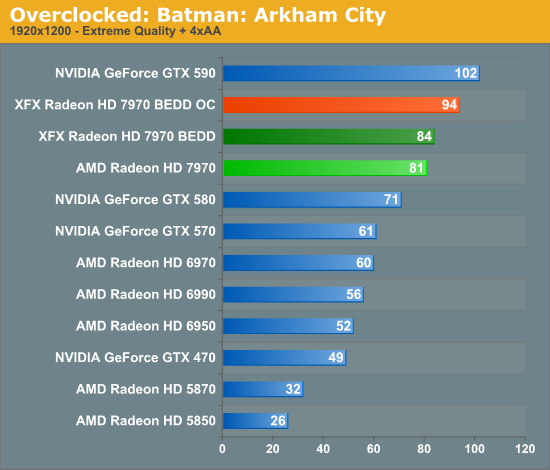
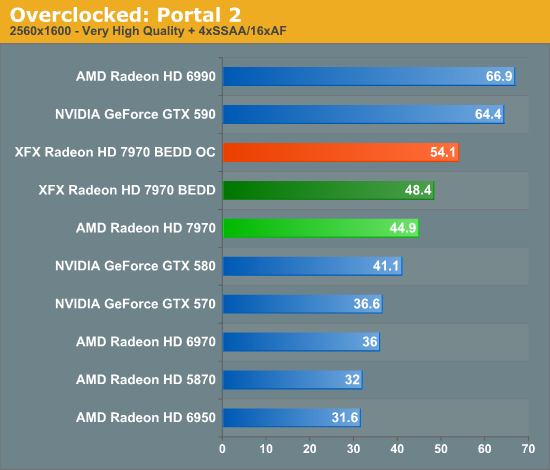
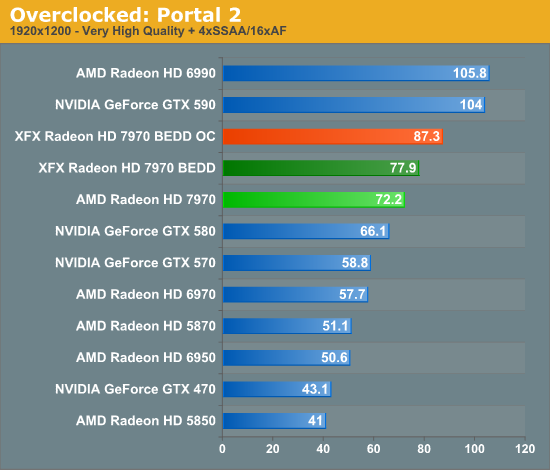
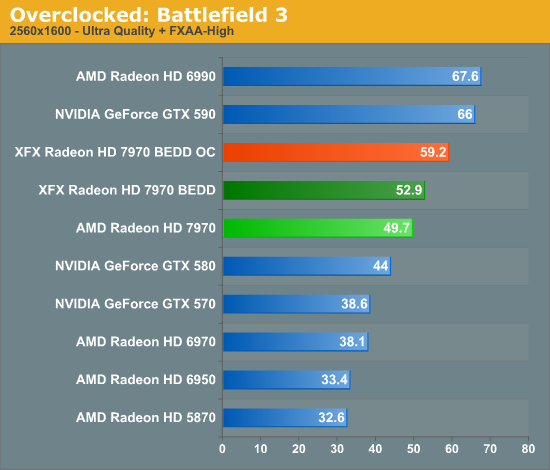
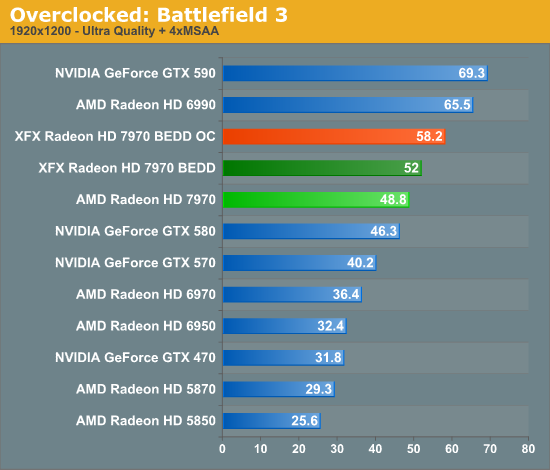
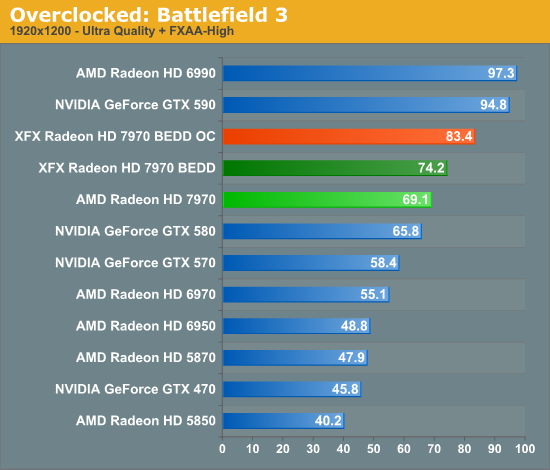
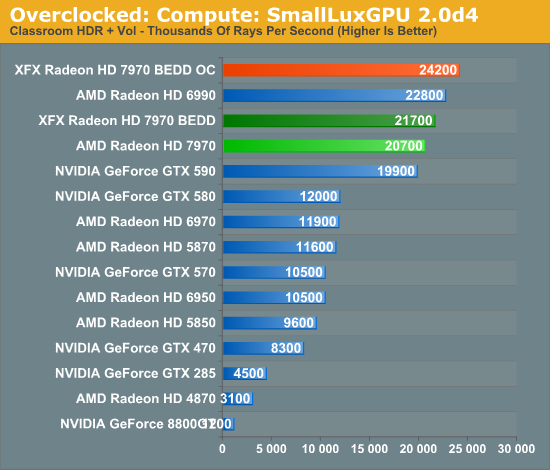
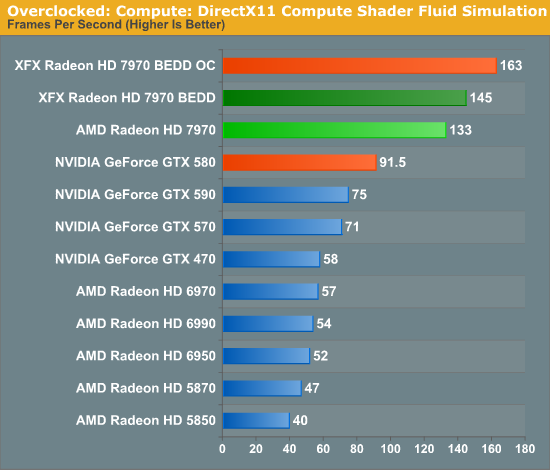
The end result of a further 11% overclock to both the GPU and memory clock results in a very consistent 11% performance increase across the board. From Crysis to Battlefield 3 everything jumps up by 11%, and the combination of the two overclocks means that our overclocked BEDD leaves just about every other single-GPU video card in the dust. Even the dual-GPU 6990 and GTX 590 have their leads seriously eroded, and in a few cases the overclocked BEDD will pull ahead of the GTX 590 in games that AMD does particularly well in. If the reference 7970 and BEDD didn’t impress you, certainly this will.
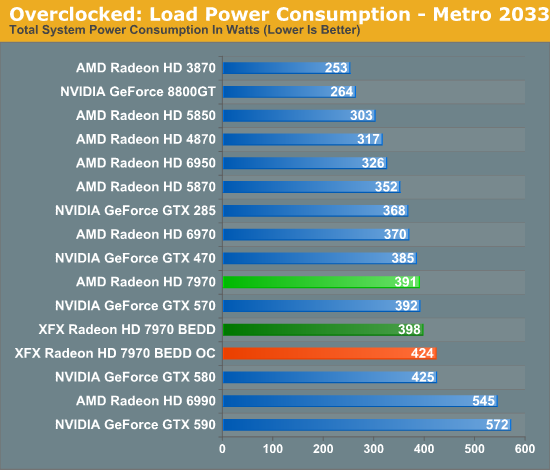
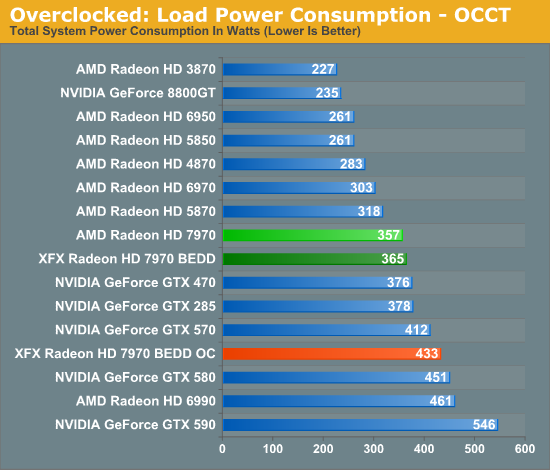
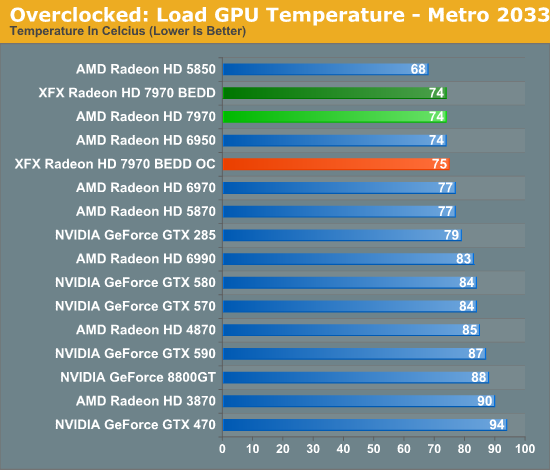
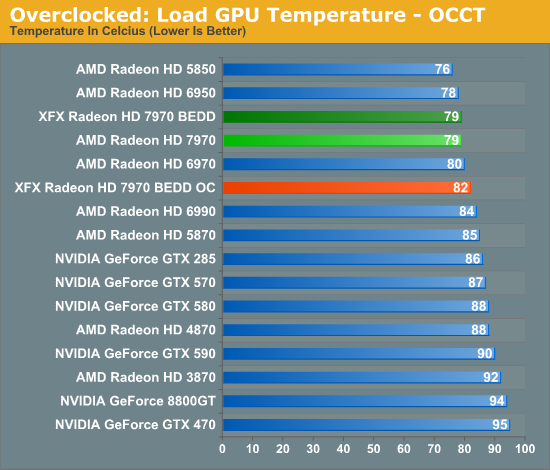
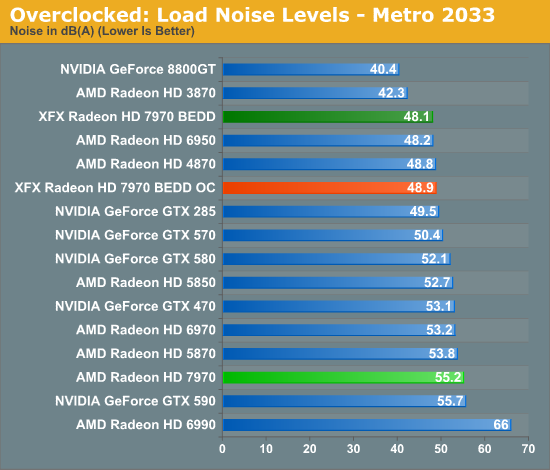
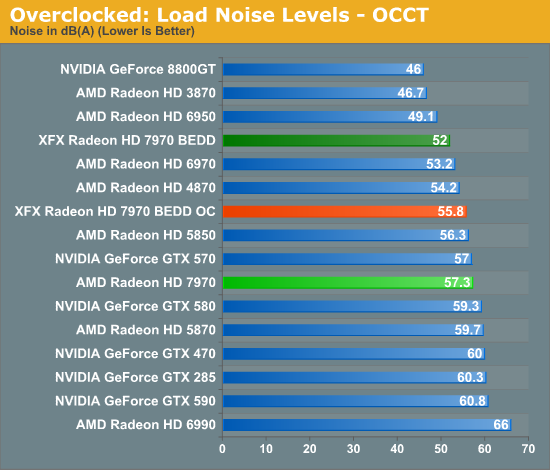
So what’s the tradeoff for this overclock? It’s actually very little. Even with our increased PowerTune limit – which doesn’t increase the power consumption, just the potential for power consumption – power consumption under Metro only rises 26W, and at least some of this will be additional work on the CPU in response to the relaxed GPU bottleneck. OCCT looks worse, but again this has more to do with the PowerTune limit than the overclock.
The fact that this overclock has had a minimal impact on the power consumption of our BEDD is reinforced by our temperature and noise data. Under Metro the overclocked BEDD gets 1C warmer and 2dB louder versus its factory clocks, which is a very small increase given the 11% overclock. So long as we don’t touch the core voltage for the BEDD (or any other 7970), the power tradeoff for overclocking is nearly non-existent, which is fantastic news given that we’ve just driven a 7970 21% over AMD’s reference clocks on reference voltage.










93 Comments
View All Comments
Duraz0rz - Monday, January 9, 2012 - link
I don't think GCN, a completely new architecture, would qualify as an "old graphics solution".Morg. - Tuesday, January 10, 2012 - link
1. yes no reason to go further than a good 5850 right now . (I still have a 4850 and it's just gone into the 'bit too shitty' zone for me)2. 6950 murders a 5850, and the new 7-series does the same to the 6-series.
3. The architecture just changed on AMD side, towards more of a vector processor, just like nVidia's Fermi, this is a good thing for compute and the future of IT in general (heterogeneous core blabla and stuff). (by the way, GCN is not all that new, it's just an adaptation of an older design)
4. Obviously, all that power is becoming a bit useless to gamers since game devs have shifted most of their focus to consoles, and the last big PC game dev (blizzard) focuses on delivering "playable" games for everyone, thus limiting the computing requirements.
5. This is 2011, You can expect that shading and tesselation will eventually enable games to look as good as your hardware can make them, with graphics settings limited to how many FPS minimum and average you want. This is especially true since future consoles will have some of that . and the next round even more.
I'd expect that kind of stuff to be mainstream around 2013 - 2014, so if you're going to keep your new box for 3 years, why not ... (on the other hand, the best graphics board for money currently still is the 6950 of course...).
And .. the tiny bit of truth : yes the gtx 580 is what the 480 was meant to be, with quite a few glitches fixed. It's obviously not meant for a 40nm process (500+ Watts in basic overclocking is a bit much) and that was part of nVidia's strategy : develop fermi on 40 nm then port it to its intended size : 28nm.
AMD waited for 28nm and I believe that was the best choice, seeing how they managed to deliver (much more easily than Fermi by the way .. which had major issues for its first release).. Just looking at the power requirements for the 7970 tells the whole story . That thing is downclocked to hell just to remain under 300 Watts ...
theprodigalrebel - Monday, January 9, 2012 - link
Should come with a warning: No motorboating the cardIceDread - Tuesday, January 10, 2012 - link
I purchased XFX radeon hd 5970 a couple of years ago. XFX are inferior when it comes to overclocking. They were more restrictive and values had to be adjusted each restart even if I remember correctly.The result was that everyone who wanted to overclock their xfx cards installed firmware from other companies to successfully be able to overclock their cards.
piroroadkill - Tuesday, January 10, 2012 - link
This was true for me, too. I had an XFX 4890 (which is dying now, despite running at stock for a long time).It had a custom (and worse) vrm section of the board, and didn't overclock worth a single damn. Those promises of 1GHz 4890s? Haha, not if you owned one of these.
Mjello - Tuesday, January 10, 2012 - link
Is it possible to control the fan manually. That would fix the idle noice easilywifiwolf - Tuesday, January 10, 2012 - link
The article stated it's already at its minimum rate since it's using the same controller as the reference card.fausto412 - Tuesday, January 10, 2012 - link
Can we get more detail info on this newly added tech?I read the AMD whitepaper buy I am curious as to real world impact of it.
Ryan Smith - Tuesday, January 10, 2012 - link
Actually PowerTune is not new. It was first introduced on Cayman (6900 series); the Tahiti (7900 series) implementation is no different.http://www.anandtech.com/show/4061/amds-radeon-hd-...
dcompart - Tuesday, January 10, 2012 - link
It'd be nice to see the overclock performance of a standard cooled card for comparison. I'd like to be able to balance the price justification not only on noise but performance. The comparison between a regular 7970 against a stock overclocked card doesn't persuade me, then it irritates me further to see the XFX overclocked further, without even playing devils advocate and showing the overclock potential of a regular 7970 with standard cooling. It doesn't make want to buy the Overclocked card, it makes me feel deceived!